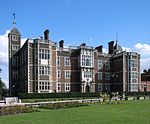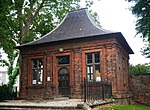Charlton railway station
1849 establishments in EnglandCharlton, LondonDfT Category D stationsFormer South Eastern Railway (UK) stationsLondon stations without latest usage statistics 1415 ... and 6 more
London stations without latest usage statistics 1516Rail transport stations in London fare zone 3Railway stations in Great Britain opened in 1849Railway stations in the Royal Borough of GreenwichRailway stations served by SoutheasternUse British English from August 2012

Charlton railway station is a railway station in Charlton, Royal Borough of Greenwich. It is 7 miles 44 chains (12.2 km) measured from Charing Cross. The station is operated by Southeastern. Trains serving the station are operated by Southeastern and Thameslink. It is in Travelcard Zone 3. Charlton station is within walking distance of The Valley, home of Charlton Athletic F.C. It was first opened in 1849 by the South Eastern Railway on the North Kent Line and is close to the junction where the routes via Greenwich and Lewisham converge (the link from Greenwich and Maze Hill being completed in 1878).
Excerpt from the Wikipedia article Charlton railway station (License: CC BY-SA 3.0, Authors, Images).Charlton railway station
Charlton Church Lane, London Charlton (Royal Borough of Greenwich)
Geographical coordinates (GPS) Address Website Nearby Places Show on map
Geographical coordinates (GPS)
| Latitude | Longitude |
|---|---|
| N 51.48686 ° | E 0.03232 ° |
Address
Sainsbury's Local
Charlton Church Lane 33-37
SE7 7AG London, Charlton (Royal Borough of Greenwich)
England, United Kingdom
Open on Google Maps









